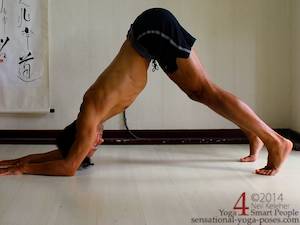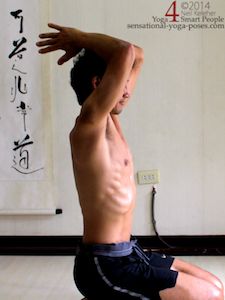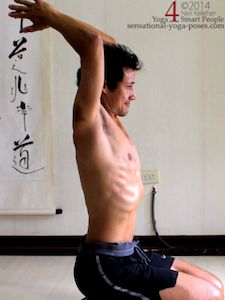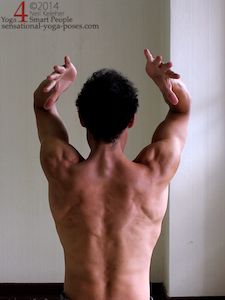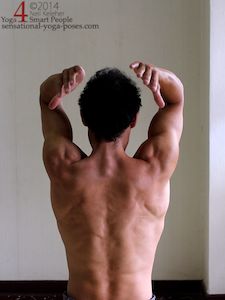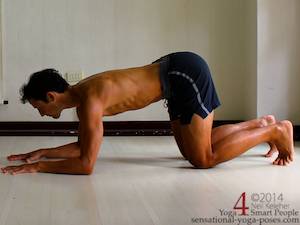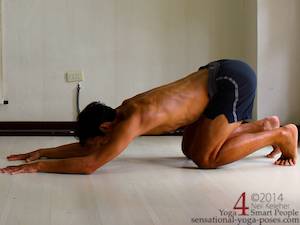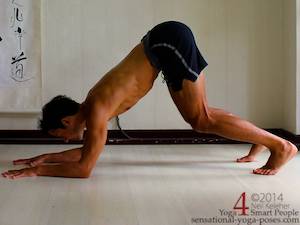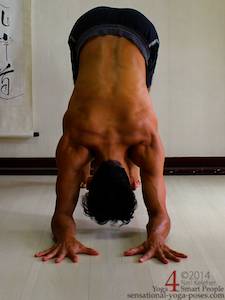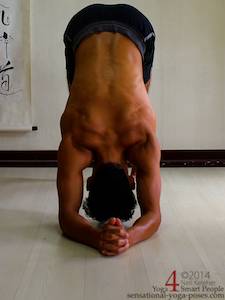Dolphin Yoga Pose
Exercises and variations for prepping your shoulders for this elbow supported variation of downward dog
Dolphin pose is a variation of downward facing dog pose but with the elbows bent and forearms on the floor. Forearms can be parallel or hands can be clasped so they form a triangle.
I think most yoga teachers, myself included, use dolphin yoga pose as a preparation for either forearm stand (pinch mayurasana) or headstand.
It's a good way to get used to bearing some or all of the weight of the body on the forearms.
But even if you aren't interested in either of those two positions, it can also be a good exercise for increasing arms-over-the-head shoulder flexibility and also rotational stability and flexibiliity.
One student wrote and asked me about this pose because her shoulders hurt when doing this pose.
Shoulder Preparation Exercises
And so a good set of starting exercises for this and any other pose where the arms are bearing weight are scapular awareness exercises.
As a prep for dolphin yoga pose,
- practice lifting and lowering the shoulders, and also protracting and retracting them with the arms down.
- Then with arms up and elbows straight practice lifting and lowering the shoulder blades.
But first set up your ribcage. Sit or stand with chest lifted and neck long.
- Then with arms upwards and palms facing inwards, work at slowly lifting your shoulders and then lowering them.
- When lifting your shoulder blades try to move your shoulders inwards as well as upwards.
- When lowering your shoulders work at spreading your shoulder blades.
Rest when you need to.
Another action that you can practice when lifting your shoulders with arms up, is reaching your arms upwards and backwards.
If you find this causes some pain or twinging, you may find it helps to focus on the peak of bone at the top of your shoulder (the accromion process.)
- Focus on moving these points upwards, inwards and rearwards.
- At the same time focus on the bottom points of your shoulder blades, moving them outwards and forwards (around the sides of the ribcage towards the front of your ribcage.)
Arms Up Shoulder Exercises with Elbows Bent
With hands clasped and elbows bent (upper arms pointing upwards), repeat the same actions but also work at keeping the elbows moving inwards. Try to keep them about shoulder width apart.
In these pictures my palms are together, but you can do this same action with hands clasped or hands apart. Move your elbows back and up while working at keeping them shoulder width apart.
In the first picture my elbows are slightly outwards. In the second picture I'm working at bringing them inwards by rotating my upper arms outwards. Note how the bottom tips of my shoulder blades have moved slightly outwards from the first picture to the second.
With hands separated and palms pointing upwards, try to keep the elbows at about shoulder with apart but aditionally work at rotating the upper arms outwards so that the hands move away from each other.
Transitioning to Weight Bearing
A good way to get used to having the weight on the arms is to rest your elbows on a counter surface or table top.
Use your forearms to push the table forwards so that your ribcage moves rearwards. Try this first with hands clasped then with hands apart and forearms parallel. Try to press down through the entire forearm. So where ever it touches the table or counter, press down evenly.
Also press down with hands and if palms are on the floor then spread the fingers and press through your fingers also.
Try to make your chest feel open and make your neck feel long, then use your arms to push the table forwards and your ribcage back. Try to make both shoulder feel even.
With hands apart work at externally rotating the arms so that you are using muscle power to maintain the distance (and angle) between the forearms.
Dolphin Yoga Pose Beginner Preparations
So that it is easier to maintain shoulder stability while working towards dolphin yoga pose I'd suggest a sequence of actions similiar to that used to train downward dog.
First keep the knees bent, use the arms to push the ribcage and hips back and up while keeping the knees bent. Then move forwards to "rest".
(You can do this first with knees on the floor and then with knees lifted.)
Repeat a few times, adjusting the distance between feet and elbows to find a position that feels right.
Next, when pushing your hips back, straighten the knees but lift the heels. Then return to the initial position, bendin your knees and relaxing the feet. Use your shoulders to push your ribcage backwards at then open your chest and lengthen your neck as you push your pelvis back and up.
Finally, as you push back, straighten your knees and push your heels down, or, focus on lifting up on the fronts of your feet, giving the back of your lower legs an active stretch. (I may be a bit optimistic in suggesting that you get your heels to the floor.)
Holding Dolphin Yoga Pose
When holding dophin pose try breathing into your upper belly. You could lengthen your spine slighty while inhaling and relax it while exhaling. While inhaling also focus on your shoulders. Relative to your ribcage, move the peaks of your shoulder blades (accromion process) back and upwards, towards your ears. At the same time move the bottom tips of your shoulder blades outwards.
If you still have difficulty with your shoulders then experiment. Some very basic actions you can play with are:
- Moving shoulder blades upwads (towards head)
- Moving shoulder blades downwards (away from head)
- Spreading shoulder blades (away from each other)
- Drawing shoulder blades towards each other.
- Moving peak of shoulder forwards, backwards, inwards or outwards.
- Moving bottom tip of shoulder blade outwards or inwards.
- Rotate upper arms inwards or outwards.
- For all variations focus on moving slowly and smoothly and rest when you need to.
Also look for a position where it feels like you have space all around the shoulder (or as much as possible.) Even bettter, look to find a position where tension feels balanced. If there is a lack of sensation in part of the shoulder or arm try lengthening outwards from the dead spot to create tension. If their is excessive tension try to relax that tension by shifting arm or shoulder so that the tension dissipates.
Published: 2015 05 13
